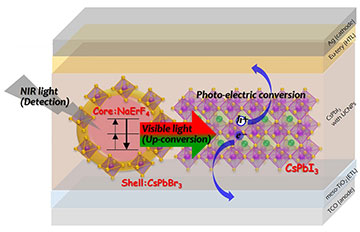A perovskite-based photodetecting device for near-infrared (NIR) was prepared by using perovskite-coated upconversion nanoparticles (UCNPs) with strong NIR absorption and high upconversion efficiency. [Image: Japan Science and Technology Agency] [Enlarge image]
Despite years of research, scientists have yet to detect weak near-infrared (NIR) signals with the same sensitivity as visible-light ones. Now researchers at two Japanese universities have designed a new NIR detection method by incorporating upconversion materials into a perovskite-based photodetector (Adv. Photon. Research, doi: 10.1002.adpr.202200222).
In the new scheme, the scientists created nanoparticles with cores made of sodium lanthanide tetrafluoride and shells coated with an inorganic perovskite. Next, they baked the particles into a photoactive film made of a different kind of perovskite. The resulting photodetector responds strongly to weak NIR light with a quantum conversion efficiency of nearly 75%.
Improving detector materials
Fields ranging from optical communications to medicine require sensors that detect weak NIR signals. The compound semiconductors that can detect NIR light with wavelengths of 900 to 1700 nm are expensive to fabricate and plagued by noise interference. In recent years, studies of lead halide perovskites have indicated that these materials are more sensitive to wavelengths shorter than 800 nm, and replacing the lead with tin helps to narrow the bandgap. However, tin-based detector materials have less efficiency and thermal stability.
In the new study, Ayumi Ishii of Teikyo University of Science and Tsutomu Miyasaka of Toin University of Yokohama began by synthesizing the nanoparticles, which incorporated erbium as the lanthanide. Next, the pair coated them with either one or two layers of a perovskite, CsPbBr3.
The particles were either 8 nm or 10 nm in diameter, depending on the number of shells. The scientists gathered emission spectra of the tiny units to verify that the coatings boosted the upconversion intensity of the cores, instead of quenching it.
Subsequently, the researchers fixed the nanoparticles into a film containing a different kind of lead halide perovskite, CsPbI3, which absorbs visible light up to a wavelength of 700 nm. They incorporated the film into a proof-of-concept photodetector with the perovskite film sandwiched between a titanium dioxide substrate and a metal-organic complex layer, topped by a silver counter-electrode.
Hopes for more efficient solar cells
When NIR radiation comes in from the substrate side, the nanoparticles upconvert it to visible light first, with the CsPbBr3 absorbing the visible light. The top two layers perform the photo-electric conversion with an external quantum conversion efficiency of 74.7%.
The authors hope that their experiments will make solar cells more efficient by harvesting the NIR light coming from the sun.


